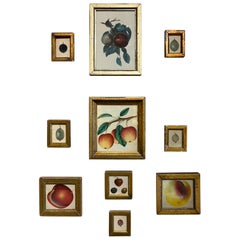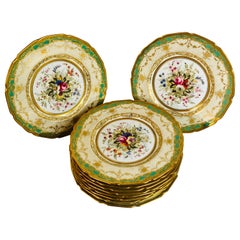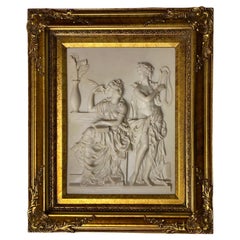Gilt Decorative Art
Early 1900s Swedish Country Antique Gilt Decorative Art
Linen, Faux Bamboo, Glass, Organic Material
20th Century Italian Rococo Gilt Decorative Art
Gold Leaf, Silver
Early 19th Century American Regency Antique Gilt Decorative Art
Giltwood, Paper
1920s English Belle Époque Vintage Gilt Decorative Art
Porcelain
20th Century Italian Baroque Gilt Decorative Art
Resin, Wood
Late 17th Century Italian Baroque Antique Gilt Decorative Art
Wood
Early 19th Century Italian Empire Antique Gilt Decorative Art
Wood
Mid-20th Century American Mid-Century Modern Gilt Decorative Art
Paint, Wood
Mid-20th Century French Mid-Century Modern Gilt Decorative Art
Iron
18th Century Italian Rococo Antique Gilt Decorative Art
Gold Leaf
2010s Slovak Gilt Decorative Art
Art Glass
19th Century French Neoclassical Antique Gilt Decorative Art
Metal
1980s Dutch Modern Vintage Gilt Decorative Art
Wood, Paint
20th Century Spanish Mid-Century Modern Gilt Decorative Art
Metal, Iron, Gold Leaf
1890s English Late Victorian Antique Gilt Decorative Art
Giltwood, Wood, Canvas
18th Century and Earlier Italian Renaissance Antique Gilt Decorative Art
Gold Leaf
20th Century French Art Deco Gilt Decorative Art
Wood, Paint
21st Century and Contemporary French Art Deco Gilt Decorative Art
Plaster
Early 1900s Italian Baroque Antique Gilt Decorative Art
Canvas, Giltwood
Mid-20th Century Italian Mid-Century Modern Gilt Decorative Art
Metal
Early 1900s Italian Baroque Antique Gilt Decorative Art
Canvas, Giltwood
Mid-20th Century Italian Baroque Gilt Decorative Art
Wood
Late 19th Century German Rococo Revival Antique Gilt Decorative Art
Canvas, Wood
19th Century French Rococo Revival Antique Gilt Decorative Art
Canvas, Giltwood
20th Century Italian Grand Tour Gilt Decorative Art
Lapis Lazuli, Malachite, Marble
19th Century Victorian Antique Gilt Decorative Art
Canvas, Wood
19th Century Chinese Ming Antique Gilt Decorative Art
Silk, Wood, Paint
Late 18th Century French Empire Antique Gilt Decorative Art
Mirror, Giltwood, Pine
Early 20th Century Burmese Art Deco Gilt Decorative Art
Wood, Giltwood
Late 19th Century German Baroque Antique Gilt Decorative Art
Gesso, Canvas, Wood
Early 1800s Italian Renaissance Antique Gilt Decorative Art
Wood, Gesso, Canvas
Mid-20th Century American Mid-Century Modern Gilt Decorative Art
Wood, Paint
Late 19th Century Italian Baroque Revival Antique Gilt Decorative Art
Canvas, Wood
Mid-19th Century Italian Rococo Revival Antique Gilt Decorative Art
Metal
Late 19th Century English Late Victorian Antique Gilt Decorative Art
Gesso, Glass, Wood, Paper
Late 18th Century French Directoire Antique Gilt Decorative Art
Wood, Paint
19th Century French Louis XVI Antique Gilt Decorative Art
Glass, Giltwood
17th Century Peruvian Antique Gilt Decorative Art
Wood, Paint, Giltwood
19th Century Italian Baroque Antique Gilt Decorative Art
Gesso, Canvas, Wood
Early 20th Century French Belle Époque Gilt Decorative Art
Porcelain
Early 20th Century European Arts and Crafts Gilt Decorative Art
Majolica, Mirror, Oak
21st Century and Contemporary Portuguese Modern Gilt Decorative Art
Brass, Stainless Steel, Gold Leaf
Mid-20th Century German Mid-Century Modern Gilt Decorative Art
Porcelain
1770s American American Colonial Antique Gilt Decorative Art
Gold Leaf
1930s French Art Deco Vintage Gilt Decorative Art
Hardwood, Paint
18th Century Italian Baroque Antique Gilt Decorative Art
Gold Leaf
Late 19th Century French Romantic Antique Gilt Decorative Art
Canvas, Wood, Plywood
Late 18th Century French Chinoiserie Antique Gilt Decorative Art
Canvas, Giltwood
Late 18th Century French Empire Antique Gilt Decorative Art
Mirror, Giltwood
19th Century French Louis XVI Antique Gilt Decorative Art
Metal, Bronze
17th Century Russian Antique Gilt Decorative Art
Gold Leaf
18th Century Italian Rococo Antique Gilt Decorative Art
Rock Crystal, Gold Leaf
Early 19th Century Italian Neoclassical Antique Gilt Decorative Art
Wood
20th Century Mexican Art Deco Gilt Decorative Art
Silver Leaf
Mid-20th Century American Brutalist Gilt Decorative Art
Iron
Late 18th Century Swedish Gustavian Antique Gilt Decorative Art
Mirror, Pine, Giltwood
17th Century Italian Renaissance Antique Gilt Decorative Art
Canvas, Giltwood, Wood, Plaster
19th Century Japanese Antique Gilt Decorative Art
Paper, Wood
19th Century French Rococo Antique Gilt Decorative Art
Masonite, Gesso, Canvas, Giltwood
Late 17th Century Portuguese Baroque Antique Gilt Decorative Art
Pine, Giltwood
Read More
At Colonial Williamsburg, Everything Old Is New Again
With the help of a new director, the Virginia institution's folk art and decorative arts museums are undergoing extensive upgrades.
New York’s Hirschl & Adler Showcases the American Workmanship and Design Panache of Neoclassical Treasures
The gallery's latest exhibition proves that museum-quality pieces entice and inspire, whether in traditional or more modern interiors.





